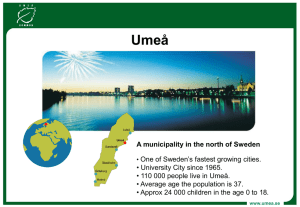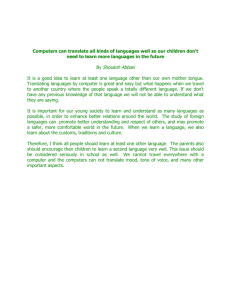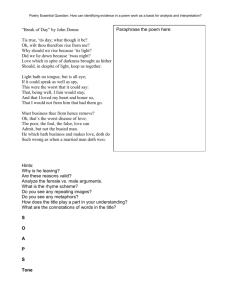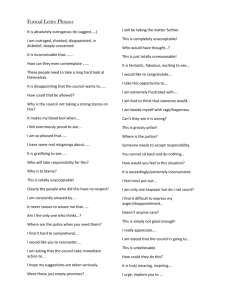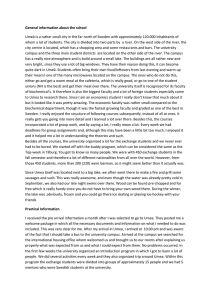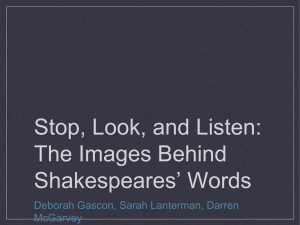qwertyuiopasdfghjklzxcvbnmqwertyui opasdfghjklzxcvbnmqwertyuiopasdfgh jklzxcvbnmqwertyuiopasdfghjklzxcvb
advertisement
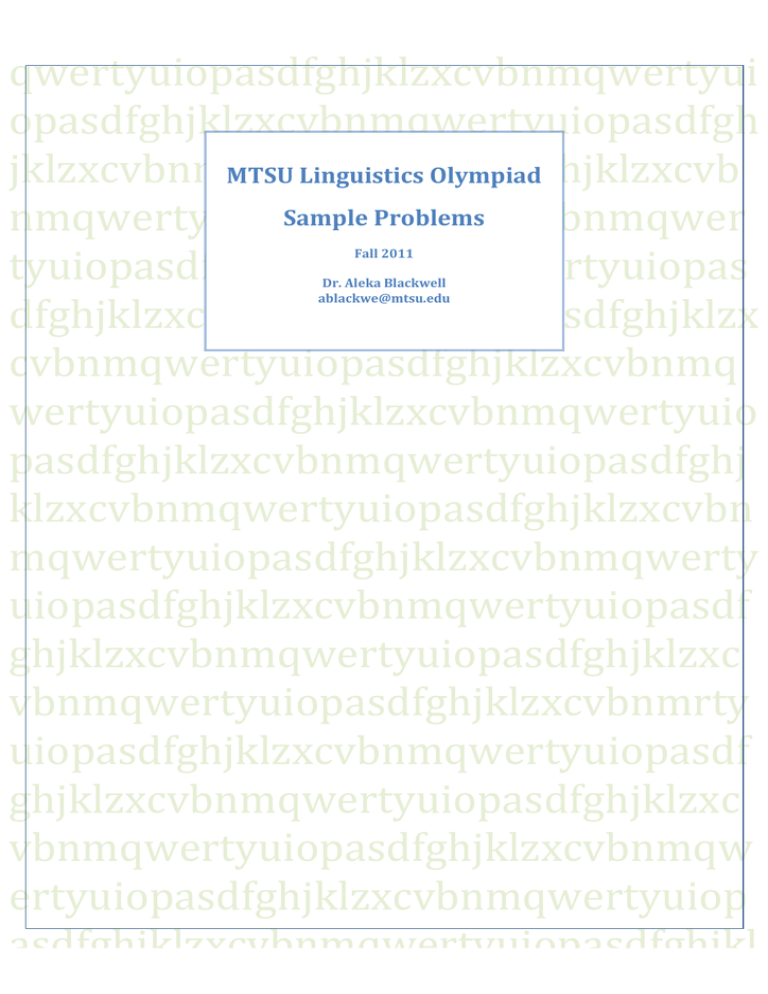
qwertyuiopasdfghjklzxcvbnmqwertyui opasdfghjklzxcvbnmqwertyuiopasdfgh jklzxcvbnmqwertyuiopasdfghjklzxcvb MTSU Linguistics Olympiad Sample Problems nmqwertyuiopasdfghjklzxcvbnmqwer tyuiopasdfghjklzxcvbnmqwertyuiopas dfghjklzxcvbnmqwertyuiopasdfghjklzx cvbnmqwertyuiopasdfghjklzxcvbnmq wertyuiopasdfghjklzxcvbnmqwertyuio pasdfghjklzxcvbnmqwertyuiopasdfghj klzxcvbnmqwertyuiopasdfghjklzxcvbn mqwertyuiopasdfghjklzxcvbnmqwerty uiopasdfghjklzxcvbnmqwertyuiopasdf ghjklzxcvbnmqwertyuiopasdfghjklzxc vbnmqwertyuiopasdfghjklzxcvbnmrty uiopasdfghjklzxcvbnmqwertyuiopasdf ghjklzxcvbnmqwertyuiopasdfghjklzxc vbnmqwertyuiopasdfghjklzxcvbnmqw ertyuiopasdfghjklzxcvbnmqwertyuiop asdfghjklzxcvbnmqwertyuiopasdfghjkl Fall 2011 Dr. Aleka Blackwell ablackwe@mtsu.edu Problem #1 Basque (native name Euskara) by Aleka Blackwell based on the brief grammar of Euskara, the Basque language, by Itziar Laka of the University of the Basque Country available at http://www.ehu.es/grammar/. The Basques call themselves euskaldun, a term that means ‘euskara speaker.’ Euskara is spoken by a population of around 700,000 people. When locating Euskara on the world’s map, Basques point to those areas Euskara is most likely to be used as primary language. In this sense of geographical location, Euskara is spoken mostly within the Basque Country (or Euskal Herria in Euskara). The Basque Country is found in the western Pyrenees, a land within Spanish borders to the West, and within French borders to the East. TASK 1. Read the following sentences, shown in Basque and in well-formed translations into English. 1. 2. 3. 4. 5. 6. 7. 8. 9. emakumeak gizona ikusi du zuk umea ikusi duzu kalean non ikusi duzu umea? nork ikusi du umea kalean? umeak ez du gizona ikusi emakumeak liburua irakurri du umea etorri da umea kalean erori da igela agertu da ‘the woman has seen the man’ ‘you (sg.) have seen the child in the street’ ‘where have you seen the child?’ ‘who has seen the child in the street?’ ‘the child has not seen the man’ ‘the woman has read the book’ ‘the child has come/arrived’ ‘the child has fallen in the street’ ‘the frog has appeared’ Your task is to translate the following: Translate into Basque: 10. The woman has come. ________________________________ 11. The man has seen the woman. ________________________________ 12. The book has not arrived. ________________________________ Translate into English: 13. Nork ikusi du gizona? ________________________________ 14. Igela kalean agertu da ________________________________ Problem #1 Continued TASK 2 Basque is a free word order language. In other words, all the phrases shown in Set A below translate into English as ‘the child has fallen in the street.’ SET A kalean umea erori da umea erori da kalean kalean erori da umea erori da umea kalean erori da kalean umea ‘the child has fallen in the street’ ‘the child has fallen in the street’ ‘the child has fallen in the street’ ‘the child has fallen in the street’ ‘the child has fallen in the street’ By contrast, all the phrases in Set B below are considered ungrammatical. That is, a native speaker of Basque would consider these structures unacceptable. SET B *erori umea da kalean *erori kalean da umea *erori umea kalean da Your task is to identify the restriction which applies to the word order options available in Basque. __________________________________________________________________ __________________________________________________________________ __________________________________________________________________ TASK 3 Now consider the following additional data. 15. gizonak umeari liburua eman dio ‘the man has given the book to the child’ 16. irakasleak umeari liburua irakurrarazi dio ‘the teacher has made the child read the book’ Your task is to translate the following: Translate into English: 17. emakumeak umeari etorrarazi dio ________________________________ Translate into Basque: 18. the child has given the frog to the woman ________________________________ Problem #2 Old English by Rhonda McDaniel Old English (also called Anglo-Saxon) is an early form of the English language that was spoken and written in parts of what are now England and southern Scotland between the mid-5th century and the mid-12th century. Speakers of Old English called their language Englisc, themselves Angle, Angelcynn or Angelfolc and their home Angelcynn or Englaland. Compounding is a process that forms new words from two independent words. In Old English compounding was frequently used to create new words for everyday usage. In the examples below, the Old English compound has been provided in the left column for each of the Modern English words/phrases in the wordhoard below. Notes on Old English characters: There are two characters used in the Old English word list that may be unfamiliar. The ‘ð’ (eth) character has the phonetic value of <th> and the ‘æ’ (ash) represents the sound of the a in cat. The ‘sc’ cluster in Old English equals modern <sh> and beginning ‘ci’ or ‘ic’ equals modern <ch>. In most instances, ‘g’ preceded and/or followed by a vowel equals modern <y>. Task. Determine the modern equivalents for the words in the Old English compounds and write them in the middle column, then match them to the modern terms found in the Modern English Wordhoard. All of the Old English words in the compounds are still in use in Modern English, though changes have occurred in spelling and pronunciation. Old English ealddagas flodwudu stanhege æppelwin wæterclað Easterfæsten haligdæg Modern Compounds old days Wordhoard Terms former times Problem #2 Continued æftergenga drenc-hus wildefyr æfenglom burgweg mannmyrðra tidwritere sealmsangere hærfest-tid cræftwyrc fyrdraca ælmesmann heafodswima bordclað pleghus æfensteorra læcecræft selfæta cildfedende Modern English Wordhoard: ship twilight Hesperus successor begger medicine cider tablecloth city street skill chronicler homicide towel lightning nursing former times tavern theater lent dragon autumn holiday psalmist wall cannibal dizziness Problem #3 Modern Greek by Aleka Blackwell Modern Greek (Νέα Ελληνικά or Νεοελληνική, lit. 'Neo-Hellenic', historically also known as Ρωµαίικα, lit. 'Romaic') is currently spoken by approximately 16 million people mainly in Greece and Cyprus, but also by minority and immigrant Greek communities in many other countries. Below are phrases presented in Modern Greek followed by a transcription into the Latin alphabet and a translation into English. 1. το βιβλιο µου 2. το θρανιο 3. µικρα βιβλια 4. το βιβλιο της 5. τα παλια βιβλια της Μαριας 6. το µικρο θρανιο 7. το βιβλιο το παλιο 8. της Μαριας τα βιβλια 9. το βιβλιο το παλιο της Μαριας 10. το παλιο το βιβλιο to vivlio mou to thranio mikra vivlia to vivlio tis ta palia vivlia tis Marias to mikro thranio to vivlio to palio tis Marias ta vivlia to vivlio to palio tis Marias to palio to vivlio ‘my book’ ‘the desk’ ‘little books’ ‘her book’ ‘Mary’s old books’ ‘the little desk’ ‘the old book’ ‘Mary’s books’ ‘Mary’s old book’ ‘the old book’ TASK 1. Translate into Greek (using the Latin transcription): 11. my desk ____________________________________________ 12. Mary’s desk ____________________________________________ 13. old desks ____________________________________________ 14. my old books ____________________________________________ TASK 2. Translate into Modern Greek the phrase ‘Mary’s little desk.’ There are as many as 8 ways to translate this phrase into Modern Greek. List as many grammatical word order combinations as you can. 15. _______________________________________________________ 16. _______________________________________________________ 17. _______________________________________________________ 18. _______________________________________________________ 19. _______________________________________________________ 20. _______________________________________________________ 21. _______________________________________________________ 22. _______________________________________________________ Problem #4 Natural Semantic Metalanguage by Tim Wilt The Natural Semantic Metalanguage is an approach to semantic analysis based on reductive paraphrase, that is, breaking concepts/words down into combinations of simpler concepts/words. Within this framework, definitions are given in terms of conceptual primes: basic concepts found in all cultures and at the core of more complex concepts, analogous to the limited set of atoms that combine in different ways to form all the materials in the world. This exercise is based on Anna Wierzbicka’s work. The list of conceptual primes is taken from her English as a Cultural Universe. Oxford: U Press (2006) 18. The three definitions are adaptations of hers appaering in Semantics: Primes and Universals (1996) 216-217. TASK 1 Three definitions are presented below in terms of conceptual primes. Match each definition to the word it best defines. The words are: ____ horrified ____ petrified The definitions are: (a) Sometimes a person thinks something like this: something very bad is happening because of this, something very bad can happen to me now I don’t want this because of this I would want to do something if I could I can’t do anything because of this, this person feels something very bad. This person is ___________. (b) Sometimes a person thinks something like this: something very bad is happening to someone I didn’t think that something like this could happen I don’t want this because of this I would want to do something if I could I can’t do anything because of this, this person feels something very bad. This person is ___________. (c) Sometimes a person thinks something like this: something very bad is happening something very bad will happen to me now I don’t want this because of this, I would want to do something if I could I can’t do anything because of this, this person feels something very bad. because of this, this person can’t move This person is ___________. ____ terrified Problem #4 Continued TASK 2 Your next task is to construct your own definitions using the conceptual primes (shown in the table below) to distinguish happy and satisfied. Note: To make the definitions easy to read, the definitions in Part A used function words such as “a” and “of” and grammatical accord such as in “person feels” and “is happening.” You may use the same type of forms in your definition. But restrict the concepts used to those given below. Categories used to organize the presentation of the primes Substantives Conceptual primes I, YOU, SOMEONE/PERSON, SOMETHING/THING, PEOPLE, BODY KIND, PART Relational substantives Determiners THIS, THE SAME, OTHER/ELSE Quantifiers ONE, TWO, SOME, ALL MUCH/MANY MUCH/MANY Evaluators GOOD, BAD BIG, SMALL Descriptors Mental/experiential predicates THINK, KNOW, WANT, FEEL, SEE, HEAR Speech Actions, events, movement SAY, WORDS, TRUE DO, HAPPEN, MOVE Existence and possession THERE, IS/EXIST, HAVE Life and death LIVE, DIE Time WHEN/TIME, NOW, BEFORE, AFTER, A LONG TIME, A SHORT TIME, FOR SOME TIME, MOMENT Space WHERE/PLACE, BE (SOMEWHERE), HERE, ABOVE, BELOW, FAR, NEAR, Logical concepts SIDE, INSIDE, TOUCHING NOT, MAYBE, CAN, BECAUSE, IF Augmentor, intensifier Similarity VERY, MORE LIKE (AS, HOW) Define happy (use as many lines as you consider necessary) Sometimes a person thinks something like this: ________________________________________________ ________________________________________________ because of this, this person ________________________________ This person is ___________. Define satisfied (use as many lines as you consider necessary) Sometimes a person thinks something like this: ________________________________________________ ________________________________________________ ________________________________________________ because of this, this person ________________________________ This person is ___________. Problem #5 Blending by Aleka Blackwell This past fall, the mobile phone company Cingular launched an advertising campaign which involved creating word “mash-ups” (more technically, creating new words through a morphological process called blending). The campaign’s premise was that Cingular’s cellular service was strong wherever one might find himself or herself. To make that point, the commercials presented new locations, such as New Sanfrankota, Kantukornia, Chilondoscow, and Japaridelphia. The names of these new locations were created by blending place names into new words: 1. 2. 3. 4. New York + San Francisco + Dakota Kansas + Kentucky + California Chicago + London + Moscow Japan + Paris + Philadelphia New Sanfrankota Kantukornia Chilondoscow Japaridelphia TASK 1 Examine closely the words created by Cingular in 1 – 4 above. Next, try to determine what linguistic constraint(s) might be at play for these blends to be acceptable in English. You need not state the constraints here. Based on your conclusions, determine which of the following blends would be acceptable or unacceptable new words. Circle your choice in each case. Madrpragthens 5. Madrid + Prague + Athens 6. New Orleans + Austin + Sacramento New Auscramento 7. San Antonio + Charlotte + Atlanta 8. Omaha + Memphis + Charleston San Charlanta Acceptable Unacceptable Acceptable Unacceptable Acceptable Unacceptable Omahmemphston Acceptable Unacceptable 9. Los Angeles + Bombay + Johannesburg Los Bombannesburg Acceptable Unacceptable 10. Moscow + Beijing + Frankfurt Moscbeijkfurt Acceptable Unacceptable TASK 2 Following the linguistic constraints you have identified, create a blend of your own, with names of locations, one which would be acceptable and one which would be unacceptable. 11. Acceptable blend ________________________________________ 12. Unacceptable blend ________________________________________ MTSU Linguistics Olympiad Sample Problem Solutions Fall 2011 Dr. Aleka Blackwell ablackwe@mtsu.edu Problem #1 Solution Euskara, the language of the Basque Country The Basques call themselves euskaldun, a term that means ‘euskara speaker.’ Euskara is spoken by a population of around 700,000 people. Languages exist in the minds of their speakers, they do not have a land of their own. Thus, when locating Euskara on the world’s map, Basques point to those areas Euskara is most likely to be used as primary language. In this sense of geographical location, Euskara is spoken mostly within the Basque Country (or Euskal Herria in Euskara). The Basque Country is found in the western Pyrenees, a land within Spanish borders to the West, and within French borders to the East. Task 1. Read the following sentences, shown in Euskara and in well-formed translation into English. 10. emakumeak gizona ikusi du 11. zuk umea ikusi duzu kalean 12. non ikusi duzu umea? 13. nork ikusi du umea kalean? 14. umeak ez du gizona ikusi 15. emakumeak liburua irakurri du 16. umea etorri da 17. umea kalean erori da 18. igela agertu da ‘the woman has seen the man’ ‘you (sg.) have seen the child in the street’ ‘where have you seen the child?’ ‘who has seen the child in the street?’ ‘the child has not seen the man’ ‘the woman has read the book’ ‘the child has come/arrived’ ‘the child has fallen in the street’ ‘the frog has appeared’ You task is to translate the following: Translate into Basque: 10. The woman has come. 11. The man has seen the woman. 12. The book has not arrived. Emakumea etorri da. Gizonak emakumea ikusi du. Liburua ez etorri da. Translate into English: 13. Nork ikusi du gizona? 14. Igela kalean agertu da. ‘Who has seen the man?’ The frog has appeared in the street. Task 2. Euskara is a free word order language. In other words, all the phrases shown in SET A below translate into English as ‘the child has fallen in the street.’ SET A kalean umea erori da umea erori da kalean kalean erori da umea erori da umea kalean erori da kalean umea ‘the child has fallen in the street’ ‘the child has fallen in the street’ ‘the child has fallen in the street’ ‘the child has fallen in the street’ ‘the child has fallen in the street’ Problem #1 Solution Continued By contrast, all the phrases in SET B below are considered ungrammatical (which we mark with the *). That is, a native speaker of Euskara would consider these structures unacceptable. SET B *erori umea da kalean *erori kalean da umea *erori umea kalean da Your task is to identify the restriction which applies to the word order options available in Euskara. Answer should make reference to the fact that erori can’t be separated from da. More generally, the word order restriction is that a MAIN VERB and its following associated AUXILIARY VERB have to be appear adjacent to each other and in that order. __________________________________________________________________ Task 3. Now consider the following additional data. 15. gizonak umeari liburua eman dio ‘the man has given the book to the child’ 16. irakasleak umeari liburua irakurrarazi dio ‘the teacher has made the child read the book’ Your task is to translate the following: Translate into English: 17. emakumeak umeari etorrarazi dio ‘the woman has made the child come’ Translate into Basque: 18. The child has given the frog to the woman Umeak emakumeari igela eman dio Problem #2 Solution Old English by Rhonda McDaniel Old English (also called Anglo-Saxon) is an early form of the English language that was spoken and written in parts of what are now England and southern Scotland between the mid-5th century and the mid-12th century. Speakers of Old English called their language Englisc, themselves Angle, Angelcynn or Angelfolc and their home Angelcynn or Englaland. Compounding is a process that forms new words from two independent words. In Old English compounding was frequently used to create new words for everyday usage. In the examples below, the Old English compound has been provided in the left column for each of the Modern English words/phrases in the wordhoard below. Notes on Old English characters: There are two characters used in the Old English word list that may be unfamiliar. The ‘ð’ (eth) character has the phonetic value of <th> and the ‘æ’ (ash) represents the sound of the a in cat. The ‘sc’ cluster in Old English equals modern <sh> and beginning ‘ci’ or ‘ic’ equals modern <ch>. In most instances, ‘g’ preceded and/or followed by a vowel equals modern <y>. Task. Determine the modern equivalents for the words in the Old English compounds and write them in the middle column, then match them to the modern terms found in the Modern English Wordhoard. All of the Old English words in the compounds are still in use in Modern English, though changes have occurred in spelling and pronunciation. Old English ealddagas Modern Compounds old days Wordhoard Terms former times flodwudu flood wood ship stanhege stone hedge wall æppelwin apple wine cider wæterclað water cloth towel Easterfæsten Easter fast Lent haligdæg holy day holiday Problem #2 Solution Continued æftergenga after goer successor drenc-hus drink house tavern wildefyr wild fire lightning æfenglom evening gloam twilight burgweg borough way city street mannmyrðra man murder homicide tidwritere tide writer chronicler sealmsangere psalm singer psalmist hærfest-tid harvest tide autumn cræftwyrc craft work skill fyrdraca fire drake dragon ælmesmann alms man begger heafodswima head swim dizziness bordclað board cloth tablecloth pleghus play house theater æfensteorra evening star Hesperus læcecræft leech craft medicine selfæta self eating cannibal cildfedende child feeding nursing Problem #3 Solution Modern Greek by Aleka Blackwell Modern Greek (Νέα Ελληνικά or Νεοελληνική, lit. 'Neo-Hellenic', historically also known as Ρωµαίικα, lit. 'Romaic') is currently spoken by approximately 16 million people mainly in Greece and Cyprus, but also by minority and immigrant Greek communities in many other countries. Below are phrases presented in Modern Greek followed by a transcription into the Latin alphabet and a translation into English. το βιβλιο µου το θρανιο µικρα βιβλια το βιβλιο της τα παλια βιβλια της Μαριας το µικρο θρανιο το βιβλιο το παλιο της Μαριας τα βιβλια το βιβλιο το παλιο της Μαριας το παλιο το βιβλιο to vivlio mou to thranio mikra vivlia to vivlio tis ta palia vivlia tis Marias to mikro thranio to vivlio to palio tis Marias ta vivlia to vivlio to palio tis Marias to palio to vivlio ‘my book’ ‘the desk’ ‘little books’ ‘her book’ ‘Mary’s old books’ ‘the little desk’ ‘the old book’ ‘Mary’s books’ ‘Mary’s old book’ ‘the old book’ TASK 1. Translate into Greek (using the Latin transcription): my desk _____to thranio mou___________________ Mary’s desk _____to thranio tis marias; tis marias to thranio____ old desks ______palia thrania____________ my old books ______ta palia mou thrania; ta palia ta thrania mou_ TASK 2. Translate into Modern Greek the phrase ‘Mary’s little desk.’ There are as many as 8 ways to translate this phrase into Modern Greek. List as many as possible. To mikro thranio tis marias Tis marias to mikro thranio To thranio to mikro tis marias Tis marias to thranio to mikro To mikro to thranio tis marias Tis marias to mikro to thranio To thranio tis marias to mikro To mikro tis marias to thranio. Problem #4 Solution Natural Semantic Metalanguage by Tim Wilt The Natural Semantic Metalanguage is an approach to semantic analysis based on reductive paraphrase, that is, breaking concepts/words down into combinations of simpler concepts/words. Within this framework, definitions are given in terms of conceptual primes: basic concepts found in all cultures and at the core of more complex concepts, analogous to the limited set of atoms that combine in different ways to form all the materials in the world. This exercise is based on Anna Wierzbicka’s work. The list of conceptual primes is taken from her English as a Cultural Universe. Oxford: U Press (2006) 18. The three definitions are adaptations of hers appaering in Semantics: Primes and Universals (1996) 216-217. TASK 1 Three definitions are presented below in terms of conceptual primes. Match each definition to the word it best defines. The words are: __b__ horrified __c__ petrified The definitions are: (a) Sometimes a person thinks something like this: something very bad is happening because of this, something very bad can happen to me now I don’t want this because of this I would want to do something if I could I can’t do anything because of this, this person feels something very bad. This person is ___________. (b) Sometimes a person thinks something like this: something very bad is happening to someone I didn’t think that something like this could happen I don’t want this because of this I would want to do something if I could I can’t do anything because of this, this person feels something very bad. This person is ___________. (c) Sometimes a person thinks something like this: something very bad is happening something very bad will happen to me now I don’t want this because of this, I would want to do something if I could I can’t do anything because of this, this person feels something very bad. because of this, this person can’t move This person is ___________. __a__ terrified Problem #4 Solution Continued TASK 2 Your next task is to construct your own definitions using the conceptual primes (shown in the table below) to distinguish happy and satisfied. Define happy (use as many lines as you consider necessary) Sometimes a person thinks something like this: ___something good happened to me___________________ ___I wanted this___________________________________ ___I don’t want anything more now____________________ ___I don’t think of anything bad now___________________ because of this, this person __feels something good_______________ This person is _ happy __. Define satisfied (use as many lines as you consider necessary) Sometimes a person thinks something like this: ___there are some good things _______________________ ___there are not many bad things______________________ because of this, this person ___ feels something good_____________ This person is _ satisfied _. Note: “Satisfied” can be distinguished by using something more qualified than “happy”. The contestants will likely offer good alternatives to Wierzbicka’s definition of happiness. Their explanation of the difference between “happy” and “satisfied” will be an important indicator of how well they have understood and applied the notion of conceptual primes. Problem #5 Solution Blending by Aleka Blackwell This past fall, the mobile phone company Cingular launched an advertising campaign which involved creating word “mash-ups” (more technically, creating new words through a morphological process called blending). The campaign’s premise was that Cingular’s cellular service was strong wherever one might find himself or herself. To make that point, the commercials presented new locations, such as New Sanfrankota, Kantukornia, Chilondoscow, and Japaridelphia. The names of these new locations were created by blending place names into new words: 1. 2. 3. 4. New York + San Francisco + Dakota Kansas + Kentucky + California Chicago + London + Moscow Japan + Paris + Philadelphia New Sanfrankota Kantukornia Chilondoscow Japaridelphia TASK 1 Examine closely the words created by Cingular in 1 – 4 above. Next, try to determine what linguistic constraint(s) might be at play for these blends to be acceptable in English. You need not state the constraints here. Based on your conclusions, determine which of the following blends would be acceptable or unacceptable new words. Circle your choice in each case. Madrpragthens 5. Madrid + Prague + Athens 6. New Orleans + Austin + Sacramento New Auscramento 7. San Antonio + Charlotte + Atlanta 8. Omaha + Memphis + Charleston San Charlanta Acceptable Unacceptable Acceptable Unacceptable Acceptable Unacceptable Omahmemphston Acceptable Unacceptable 9. Los Angeles + Bombay + Johannesburg Los Bombannesburg Acceptable Unacceptable 10. Moscow + Beijing + Frankfurt Moscbeijkfurt Acceptable Unacceptable TASK 2 Following the linguistic constraints you have identified, create a blend of your own, with names of locations, one which would be acceptable and one which would be unacceptable. 11. Acceptable blend ___correct answers will vary_________________ 12. Unacceptable blend ___correct answers will vary _______________
